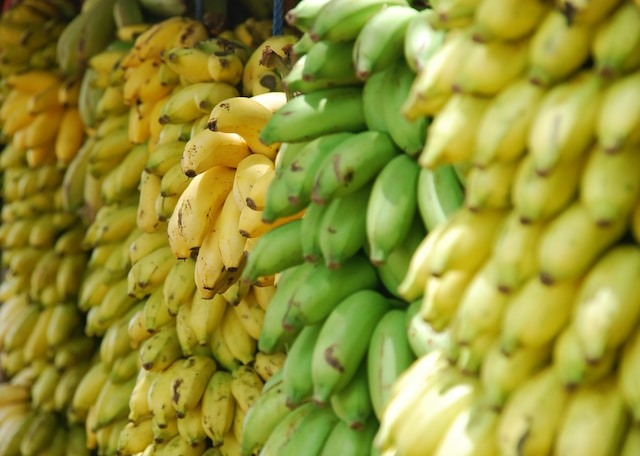
Plantains and bananas are two delicacies enjoyed by people all around the world. Although They appear the same on the surface level, they differ in uses and nutritional value.
Plantains, for starters, are larger and harder than bananas. And they come with a starchy, savoury flavour that makes them ideal for cooking.
Bananas, on the other hand, are sweeter and softer, and are frequently consumed raw as a snack or blended into smoothies and desserts.
Despite their obvious differences, plantains and bananas are rich in nutrients and appreciated for their benefits all around the globe.
We’ll examine these incredible fruits and investigate their distinct traits, uses, and advantages. Whatever you prefer, savoury or sweet meals, you’ll surely find something to adore about these great fruits. Let’s get started and discover more about plantains and bananas!
Plantains vs. Bananas: Testing The Nutritional Content
| Nutrient | Plantains | Bananas |
| Calories | 122 | 89 |
| Carbohydrates | 31 g | 23 g |
| Protein | 1.2 g | 1.1 g |
| Fiber | 2.3 g | 2.6 g |
| Vitamin A | 112 IU | 64 IU |
| Vitamin C | 18.4 mg | 8.7 mg |
| Potassium | 499 mg | 358 mg |
| Magnesium | 36 mg | 27 mg |
| Phosphorus | 34 mg | 22 mg |
| Iron | 0.5 mg | 0.3 mg |
Health Advantages
Despite the differences in nutritional and chemical value, both share several similar traits. Here are some examples of potential health benefits:
Heart Health?
- Plantains and bananas contain dietary fibre that helps lower cholesterol levels and lowers heart disease risk.
- Similarly, Bananas are high in potassium, which helps regulate blood pressure and lowers heart attack risk.
- Moreover, both have antioxidant characteristics that can greatly benefit your heart.
Digestive Health
- The fibre-rich content of both plantains and bananas supports digestive health by encouraging regular bowel movements and reducing constipation.
- Plantains also contain resistant starch, a carbohydrate that resists digestion in the small intestine and encourages good gut bacteria growth.
Eye Health
- They both contain Vitamin A, which shields the eye’s surface and prevents dryness.
- Vitamin A also greatly helps to maintain excellent vision.
Making Good Recipes
Plantains and bananas have different culinary applications. Both fruits are utilised in various cuisines depending on their ripeness and the desired flavour profile.
- For example, Plantains are frequently used in savoury meals like stews and fried appetizers, whereas bananas are more commonly used in sweet dishes like smoothies and desserts.
Also read: How To Make a Delicious Banana Milkshake
Availability And Ripeness
Correct amount of ripeness can dramatically influence the flavour and texture of plantains and bananas.
- Plantains are commonly cooked when green or yellow, but bananas are only savoured when completely ripe and turn yellow or brown.
- Bananas are grown predominantly in tropical locations and are available year-round.
- While Plantains typically grow in tropical regions such as Central and South America, the Caribbean, and West Africa,
Cultural Importance
Bananas and plantains are cultural and gastronomic staples in many parts of the world. They have played important roles in traditional cuisines and cultural practices for millennia.
On the other hand, Plantains are used in various recipes throughout Latin America, including Mofongo in Puerto Rico, Tostones in Cuba, and Patacones in Colombia. They are also utilized in various sweet and savoury treats across the region.

Where To Find Them?
Both fruits have a long history, with evidence of plantains being planted in Papua New Guinea as early as 500 BCE and bananas being grown in the Philippines as early as 200 BCE. They have been utilised throughout history not just as food but also for medical purposes and in religious ceremonies.
Bananas are popular in South American cuisine, particularly in sweets like banoffee pie in the United Kingdom and bananenbrood in the Netherlands. Plantains are a traditional cuisine in many African cultures, frequently prepared and served alongside stews or other foods.
Bananas are used in several foods throughout Southeast Asia, including banana flower salad in Thailand and pisang goreng (fried bananas) in Indonesia. Plantains can also be found in various Caribbean and West African foods, including fufu and matoke.
So, What To Choose??
The final decision between the two comes down to personal preference and the desired flavour profile for the dish. Plantains have a starchy, mildly savoury flavour and are frequently used in savoury meals, and bananas have a sweeter flavour that is more commonly used in sweet foods.
Both fruits have comparable levels of most vitamins and minerals in terms of nutritional value.
- Regarding nutritional value, Plantains provide more calories, carbohydrates, and fibre than bananas, which can benefit people trying to improve their fibre consumption.
It’s also worth noting that how these fruits are prepared and cooked impacts their nutritional value.
- Fried plantains, for example, have more calories and are less nutritious than boiled or baked plantains. Similarly, high-sugar, high-fat banana desserts are not as healthful as fresh or frozen bananas.
Generally, both plantains and bananas are part of a healthy and balanced diet. C between them should be based on personal preference and their intended use in a dish.
Our Choice?
Plantains have a higher nutritional value than bananas in terms of calories, carbs, protein, and fibre and, therefore, are much more likely to positively impact health.
However, both fruits are high in vitamins and minerals, with plantains high in vitamin A and magnesium and bananas high in vitamin B6. Plantains enjoy much more diverse cuisines.
Plantains are also low in fat and salt and high in fibre, potassium, and fibre. Furthermore, Plantains also have antioxidant qualities that aid in disease prevention.
There are no wrong choices, and decisions must be solely made on your cooking preference. So whatever your choice is, do take note of the nutritional value and all the important factors stated above, choosing between the two.
Conclusion
Regardless of these distinctions, plantains and bananas are versatile fruits that can be utilised in various cuisines. When cooking or deciding between the two, analysing the distinctions and similarities is critical.
Plantains may be a better choice if you’re looking for a fruit to utilize in a savoury recipe because of their starchy, savoury flavour. Bananas, conversely, are a preferable choice for sweet fruit to include in a dessert or smoothie because of their sweetness and softer texture.
When deciding between fruits, it’s also crucial to understand their nutritional worth. Plantains, for example, is preferred if you want to improve your fibre intake. Bananas, on the other hand, are a better choice for increasing your vitamin B6 intake.
Similar: Red Curry vs Green Curry: What?s The Difference?
FAQs
Can plantains be eaten raw like bananas?
Unlike bananas, plantains are normally not eaten raw since they are starchy and rough. Plantains are often cooked before consumption and can be boiled, fried, or baked.
Are plantains more nutritious than bananas?
Both plantains and bananas are high in fibre, vitamins, and minerals. However, their nutritional profiles differ slightly. Plantains include more calories and carbohydrates than bananas but also contain more nutrients such as vitamin A and potassium.
Can you use plantains for bananas in recipes?
They are generally used sparsely in recipes. It’s important to remember that plantains are starchier than bananas, so the final dish will have a different texture and flavour.
Hey welcome to my blog . I am a modern women who love to share any tips on lifestyle, health, travel. Hope you join me in this journey!

Speak Your Mind